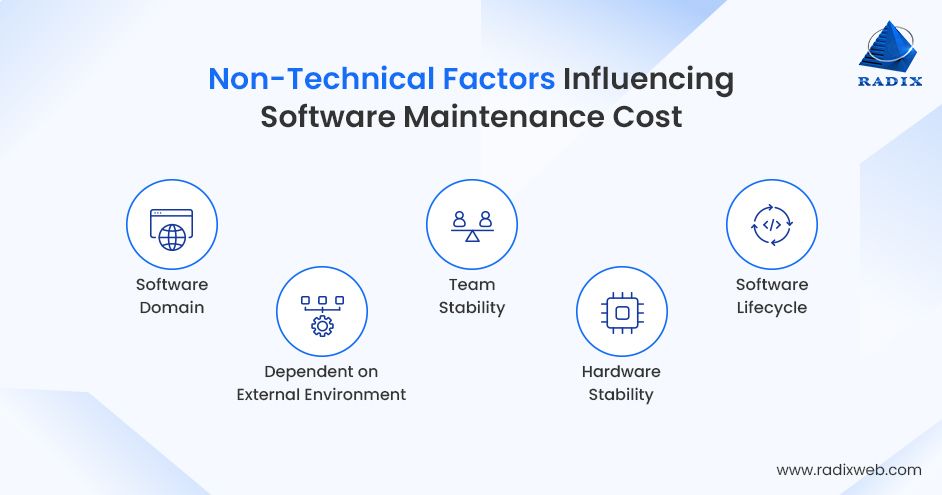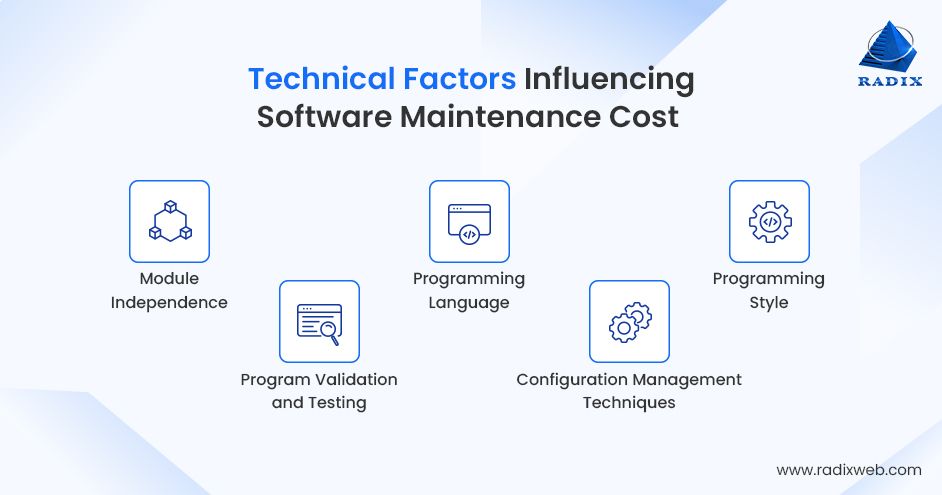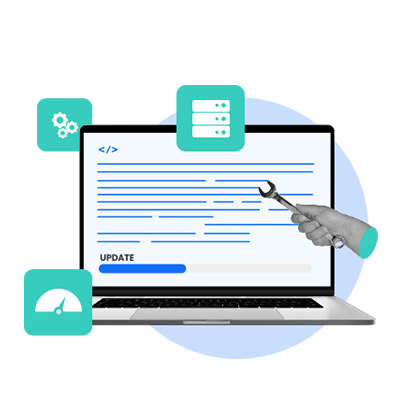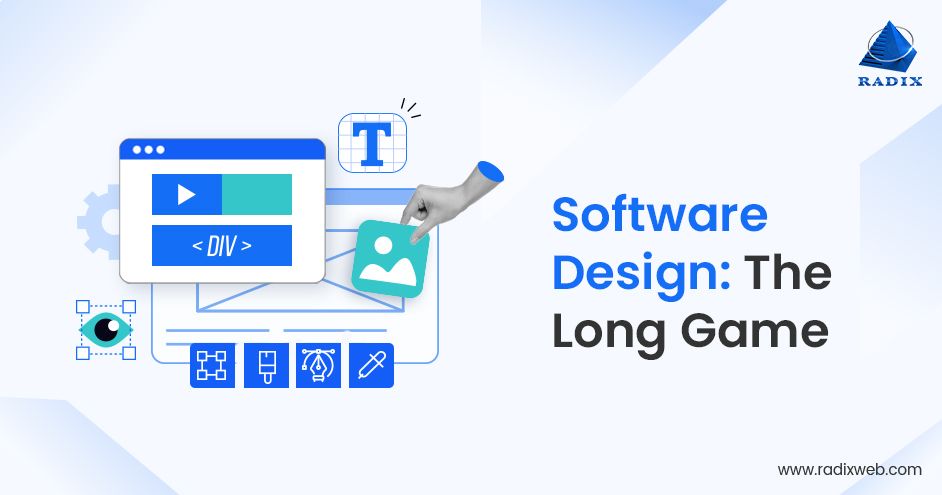Read More

Skip Setup Headaches and Start Your Project Fast - Download Free Boilerplates
ON THIS PAGE
- What is Software Maintenance?
- Software Maintenance and Its Types
- Software Maintenance Models
- What are Software Maintenance Activities?
- Why Software Maintenance is Important?
- Maintenance Process in Software Engineering
- How Much Does Software Maintenance Cost?
- Challenges in Software Maintenance
- What are Software Maintenance Tools?
- Keys Software Maintenance Strategies to Implement
- Future Proof Your Software with Radixweb!
ON THIS PAGE
- What is Software Maintenance?
- Software Maintenance and Its Types
- Software Maintenance Models
- What are Software Maintenance Activities?
- Why Software Maintenance is Important?
- Maintenance Process in Software Engineering
- How Much Does Software Maintenance Cost?
- Challenges in Software Maintenance
- What are Software Maintenance Tools?
- Keys Software Maintenance Strategies to Implement
- Future Proof Your Software with Radixweb!
Quick Summary: Software maintenance is a significant process that ensures your systems are performance-optimized, bug-free, and secure. Continuous maintenance is essential for developers to minimize technical debt and prevent code erosion. This blog defines software maintenance as the process of updating and optimizing software to meet changing needs, improve security, and reduce costs.
In the dynamic era of modern software engineering, launching a product marks the start of a journey. Software maintenance is imperative not only to resolve security gaps or fix issues but also to ensure higher business value, better productivity, and long-term stability. As market demands change, user expectations rise, and systems scale, the importance of the maintenance phase in software engineering becomes key to long-term success. This is why you can expect the software maintenance service market to reach USD 180 billion by 2033.
So, for software developers and engineers, it's not just about writing new code or programming — it's keeping digital solutions efficient, minimizing technical debt, and preserving code quality. And without a clear maintenance strategy, even developing the most innovative software after a certain time becomes vulnerable, shaky, and outdated, leading to reduced user retention, compliance risks, and higher expenses.
This blog is your in-depth guide on why maintenance and improvement of existing software is crucial from a business point of view and how developers create futuristic, maintainable systems.
What is Software Maintenance?
Software maintenance is the ongoing process of updating and modifying software applications after they are deployed initially. It ensures your digital systems function securely and efficiently and align with your changing business goals and objectives. So, whether leveraging new technologies, improving performance, preventing any security breaches, or rectifying issues, maintenance phase in software development lifecycle is crucial.
To stay highly relevant in today’s competitive market, you need to analyze your software on a regular basis and update it constantly.
Once, the software testing specialist, Michael Bolton, said, “The problem is not that testing is the bottleneck. The problem is that you don’t know what’s in the bottle. That’s a problem that testing addresses.” And this is why software maintenance is vital!
What are the Four Types of Software Maintenance?
There are four different software maintenance types, which are defined for various reasons and purposes. A software product may have to undergo one or more types of maintenance throughout its lifecycle.

1. Adaptive Maintenance
Adaptive software maintenance is adapting the system to keep the software compatible with changing business needs and technical evolution. This primarily focuses on software frameworks. It is made in response to new operating systems, platforms, and hardware to retain continuity with the software.
Adaptive software maintenance is about changing software in response to changes in its environment.
The primary goal of adaptive software maintenance is to update and modify the software when:
- The operating system your software executes is evolving (due to technology, laws, policies, rules, operating systems, etc.)
- End-users require the product to work with new hardware or software.
- You've foreseen software defects that will harm your customers in the future.
2. Perfective Maintenance
Perfective Maintenance modifies all elements, functionalities, and abilities to enhance system operations and performance. The software’s receptiveness and usability are ensured by perfective software maintenance. It includes altering software functionality by improving, removing, or inserting new features or functions.
Perfective software maintenance activities focus on functional enhancements to improve the user experience.
Perfective software maintenance includes:
- Performance enhancement
- Enhanced user interfaces and software usability
- Better software functionality and performance
3. Corrective Maintenance
Identifying errors in the existing solution and correcting them to make it work more accurately. This software maintenance activity aims to eliminate and fix bugs or issues in the software. Corrective software maintenance is usually done in the form of minor updates frequently. In a nutshell, corrective software maintenance occurs when there are errors and faults in logic, code, and design.

Corrective software maintenance is about correcting software bugs, errors, and defects.
You can implement corrective software maintenance techniques when:
- Software doesn’t function properly due to faulty logic flow, wrong implementation, invalid or incomplete tests, etc.
- Users face issues with the software once it is published.
4. Preventive Maintenance
Preventive software maintenance service helps in preventing the system from any forthcoming vulnerabilities. Preventive maintenance defines software improvements, which are done to safeguard the software for the future. It is carried out to prevent the product from any potential software alteration. Preventive maintenance also makes scaling or maintaining your code and handling your legacy system easier.
Preventive software maintenance defines the adaptations and modifications of the software that mitigate the risk of deterioration.
Preventive maintenance offers:
- Document updating as per the existing state of the system
- Code optimization for better software execution
- Reconstructing or reducing the code of the software to make it understandable
Software Maintenance Models
Software maintenance models help with workflow execution, resource allocation, and decision-making after the software deployment.
Let's now go through the most prominent software maintenance models:
Boehm’s Model
This ROI-driven model focuses on maintenance activities, considering cost-benefit analysis. It helps integrate feedback loops to reallocate resources and track performance.
Suitable For:
- Projects with long-term evolutions and consistent change requests
- Enterprises focused on ROI maintenance
Taute Maintenance Model
It is an organized, lifecycle-based model consisting of stages, including change requests, documentation, coding, scheduling, estimation, testing, and deployment. It also helps with continuous improvement through project-oriented steps.
Suitable For:
- Enterprise software maintenance for better predictability, documentation, and compliance
- Teams maintaining large-scale or mission-critical systems
What are the ‘Must-Do' Software Maintenance Activities?
Software system maintenance activities include more than just coding - it’s all about end-to-end reliability and sustainability:
Product Optimization
- Minimizing latency
- Performance tuning
- Refactoring a bloated codebase
- Load testing
Software Development Process Automation
- Rollback systems and deployment monitoring
- Using code quality scanning tools like SonarQube
- Automating unit, integration, and regression tests
- CD pipelines
Application Maintenance and Support
- Ensuring uptime via support SLAs
- Minor optimizations
- Small feature modifications
- Bug resolution
Hosting and Infrastructure Maintenance
- OS and platform patching
- Auto-scaling and load balancing
- Cloud service monitoring
- Frequent server health checkups
Backup and Disaster Recovery (DR)
- Business continuity planning
- Recovery testing
- Failover systems
- Scheduled backups
Why Do We Need Software Maintenance?
The long lifespan of software depends on its ability to be upgraded to run smoothly on the system. Therefore, following are some best reasons for system maintenance:
Bug Fixing
In software maintenance management, bug fixing is a priority to run it seamlessly. This process involves searching for errors in code and correcting them.
Capability Enhancement
This improves software features and functionalities to make it more compatible with the varying market environment. It optimizes software platforms, work patterns, hardware upgrades, compilers, and other system workflow aspects.
Removal of Outdated Functions
The unwanted functionalities occupy space in the solution, degrading the overall software efficiency. Using a software maintenance strategy, you can remove UI and coding elements and replace them with the latest software development trends.
Performance Improvement
To improve system performance, developers detect issues through testing and resolve them. It helps secure the solution from any loopholes or vulnerabilities.
Enabling Continuous Delivery and DevOps Culture
In the modern DevOps and Agile ecosystem, software product maintenance is integrated into the continuous integration and deployment (CI/CD) cycle. Hence, it upgrades the software, allows feature flags and A/B testing, ensures rollback safety, and delivers updates faster.
Managing Technical Debt
After a certain time, code shortcuts, poor architecture, and obsolete libraries might lead to technical debt. Preventive maintenance, like documentation updates and code refactoring, helps minimize technical debt, ensuring your custom software solution remains maintainable and scalable.
Minimizing Long-Term Costs
Reactive maintenance is considerably more costly than proactive maintenance. Some studies state that preventive maintenance helps reduce any future tech debt, and fixing issues after the deployment can cost 6x to 100x more than during the development process. Hence, investing in software maintenance and upgrades can lead to substantial cost savings.
Supporting Business Agility
Modern enterprises must pivot quickly. So, whether it's responding to client reviews, entering emerging markets, or launching a new product, software should adapt quickly. Hence, without proper software development maintenance plan, modifications can get expensive.
Hence, with the reasons listed above, it becomes necessary to learn the software maintenance process and choose a reliable software development partner. These go a long way in making the software robust and free from bugs.
Step-By-Step Maintenance Process in Software Engineering
The software maintenance includes a step-by-step process to ensure optimal functionality, overtime improvement, and quick adaptation to changing environments. Let's now go through the software maintenance life cycle:

Step.1: Problem Identification Phase
In this phase, your tech team takes note of the modification requests and allocates identification numbers to each. Then, software developers analyze every modification request to define whether it's an adaptive, corrective, preventive, or perfective maintenance activity. After this classification, they focus on every request to check which one to prioritize and process first.
Step.2: Problem Analysis Phase
The problem analysis phase helps with the scope and feasibility of every validated modification request. Here, developers plan the changes to be made to the software. Here, the input attribute consists of project documentation, repository information, initial estimate of resources, and validated modification requests.
Step.3: Design phase
In this stage, developers build new modules that require modification or replacement based on the earlier specification. They also develop test cases with a keen focus on safety and security to verify the software. It also includes several activities like,
- Building regression tests
- Building test cases for a new design
- Revising the modification list
- Modifying software module documentation
Step.4: Implementation Phase
In this phase, developers make the necessary modifications to the code, modernize the whole software, integrate new features, and add specifications. The input attribute comprises project documentation, modified system, source code, and the design phase output.
Step.5: System Test Phase
In this phase, the testing team carries out integration testing between the systems and new modules. This ensures no new faults or bugs in the software after its modification.
At last, developers go with regression testing to thoroughly test the entire software system. This helps them test updated software documentation and review reports.
Step.6: Acceptance Test Phase
In this software maintenance life cycle phase, third-party or internal users define and perform tests on the completely integrated system.
The goal is to check whether the new features meet the specifications mentioned in the modification request. The input attribute includes an integrated system, acceptance test plans, procedures, and cases.
Step.7: Delivery Phase
After a successful acceptance test, the team can deliver modified software to the end users. Also, they provide exhaustive documentation that consists of manuals and files that define the hardware specifications and how the software functions.
How Much Does Software Maintenance Cost?
The cost of the specific software can be categorized into three different components: Software License, Software Maintenance, and Implementation Services.
However, the maintenance cost of software can be categorized into two parts.
- Non-Technical Factors
- Technical Factors
1. Non-Technical Factors
The non-technical factors for average software maintenance cost are:

- Software Domain: When the domain of the software is well-defined, system requirements may not change over time. This will lead to fewer chances of maintenance.
- Team Stability: When a new team member joins the development team, it takes some time to get their hands on the software development process. Therefore, it becomes quite challenging to make changes to the software. This will add a cost to the software maintenance.
- Software Lifecycle: When software becomes obsolete, the original hardware changes, and the conversion cost exceeds the rewriting cost.
- Dependent on External Environment: When software is dependent on the external environment, it must be modified whenever the external environment changes.
- Hardware Stability: Software maintenance expenses are reduced to zero if the software executes on a specific hardware configuration that does not change during the entire software lifecycle. However, this is a rare occurrence due to ongoing hardware development.
2. Technical Factors
The technical factors for average maintenance cost of software are:

- Module Independence: The ability to update any software block without impacting the others.
- Programming Language: Software written in a high-level programming language is generally easier to understand than written in a low-level language.
- Programming Style: The developer's writing method determines the ease of updating and understanding software.
- Program Validation and Testing: The more time spent evaluating the design and testing of the software, the fewer bugs it contains and the lower the cost of software maintenance. The type of error determines the price of resolving errors. Errors in software requirements are the most expensive.
- Configuration Management Techniques: Keeping track of system documentation and ensuring uniformity are among the costs involved. This means that good configuration management can help you save money.
Typical Cost Breakdown
These software maintenance cost breakdown percentages might differ depending on your business domain.
| Activity | % of Maintenance Budget |
|---|---|
| Bug Fixes | 20–25% |
| Performance and Optimization | 15–20% |
| Feature Improvements | 30–40% |
| Security Updates | 10–15% |
| Compliance and Documentation | 5–10% |
How to Reduce Software Maintenance Costs?
- Automate testing and deployment
- Invest in code quality early
- Prioritize maintenance tasks strategically
- Document everything
- Refactor your code frequently
- Use scalable, well-supported tools and framework
- Hire expert software maintenance company
Now you may have an idea about the costs you might incur for software maintenance support. You must wonder what tools to deploy to make the software product maintenance process seamless.
What are Software Maintenance Tools?
Software maintenance tools are facilities, libraries, and platforms designed to help IT teams, developers, and engineers optimize, monitor, support, update, and manage software after its deployment. These tools help ensure the software continues to function securely, efficiently, and in alignment with your business objectives.
They help recognize and rectify issues, minimize downtime, enhance productivity, and reduce manual efforts. Let's now go through some of the prominent software maintenance tools.
- Docker – Containerization for environment consistency
- Kubernetes – Orchestration of containerized apps
- New Relic – Real-time application performance monitoring (APM)
- Prometheus + Grafana – Dashboarding stack and open-source monitoring
- GitLab CI/CD – Full DevOps lifecycle support
- Jenkins – Extensible CI/CD automation server
- Cypress – Modern frontend testing framework
- Postman – API testing and automation
- Jira – Industry standard for backlog management and agile issue tracking
- Trello or Asana – Lightweight platforms for smaller teams
- Bugzilla – Open-source bug tracker
What are the Challenges of Software Maintenance?
After having a thorough understanding of what software maintenance is, your organization must keep a regular check to prevent fatal incidents and save costs. Moreover, you might come across some significant challenges of software maintenance, including:
- Skill Shortage – Legacy software systems might require domain expertise.
- Lack of Prioritization - Maintenance is sometimes deferred to make way for new features.
- Tooling Gaps – Outdated tools or a lack of automation increases manual and redundant tasks.
- Poor Documentation – It leads to delays in the debugging and onboarding process.
- Technical Debt - Accumulated shortcuts make the software updates and maintenance not so easy.
Keys Software Maintenance Strategies to Implement
Successful software maintenance is not merely a process to fix bugs—it's about creating workflows, habits, and tools to ensure your solution remains efficient, secure, and scalable. Enlisted are the top strategies your team can implement to maintain product agility, control expenses, and minimize technical debt.
Use CI/CD for Faster Releases – CI/CD pipelines help make rollbacks safer and faster, minimize manual errors, and automate processes like builds, tests, and releases.
Prioritize Regular Refactoring – After a point in time, well–written code also gets chaotic. Hence, regular refactoring helps minimize redundancy and complexity and improves code structure and readability.
Pro Tip: You can assign 10–20% of sprint capacity to refactoring stories or code cleanup.
Implement Robust Monitoring and Logging - Monitoring helps provide visibility into usage patterns and system health. And logging helps with immediate debugging when issues arise suddenly.
Track and Sort Maintenance Requests – You can use a dedicated backlog for software maintenance and upgrade activities.
These strategies will significantly help you modify the overall code and fix glitches before they occur. This way, you can hold the secret key to successful software project delivery.
Turn Maintenance into Momentum with Radixweb!Today, software maintenance is essential not just for ensuring your digital assets are sound and running but also for keeping them up-to-date and relevant as the market evolves. As software development environments advance, the capability to proactively maintain, grow, and optimize your system becomes a key driver of higher ROI, user satisfaction, and business agility.And for software developers, this signifies opting for a visionary approach that encourages continuous improvement, infrastructure resilience, security updates, and code sustainability.That’s where you can join hands with Radixweb as your strategic software maintenance partner. With more than two decades of experience in managed application support, performance optimization, and legacy modernization, our engineering teams are proficient in extending the product lifecycle, optimizing system uptime, and minimizing technical debt.So, whether you’re looking to reengineer a legacy app, manage a complicated enterprise system, or scale a SaaS platform, we deliver software maintenance and support services that conform to your development culture and business objectives.Contact us to transform your software into a future-ready asset.
FAQs
How is software reengineering different from software maintenance?
How often should software be maintained?
What type of maintenance task involves fixing bugs?
How does software maintenance impact business productivity?
What are the benefits of maintenance system?
Ready to brush up on something new? We've got more to read right this way.








